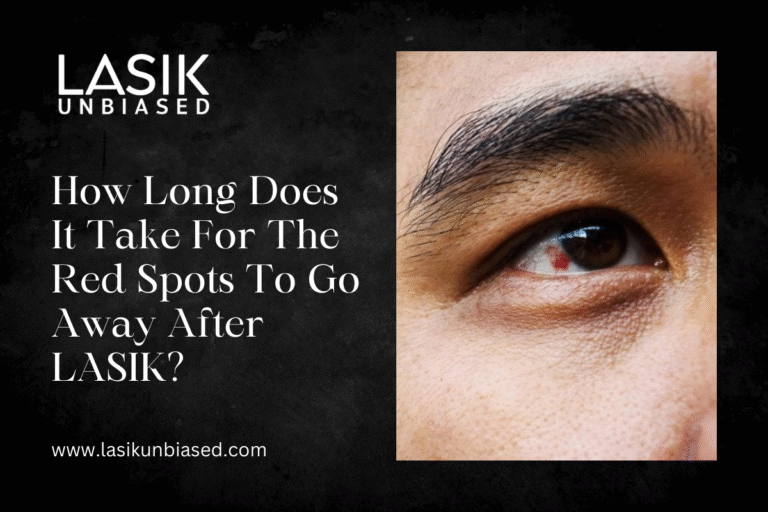The red spots that appear after LASIK surgery typically take 7 to 14 days to fade, depending on the individual.
These spots are harmless and a natural result of the procedure, but their healing time can vary based on factors like overall health, adherence to aftercare instructions, and the body’s natural recovery rate.
What Causes Red Spots After LASIK?
Red spots are tiny bruises on the white part of the eye, also known as subconjunctival haemorrhages. These occur when small blood vessels in the conjunctiva rupture during the surgery. LASIK involves creating a corneal flap using suction, which can temporarily increase pressure inside the eye and cause these ruptures.
It’s important to note that these red spots:
- Do not affect your vision.
- Are painless.
- Are temporary and do not indicate any complications.
These bruises are comparable to small, superficial cuts on your skin that gradually heal over time as your body repairs the broken vessels.
Factors That Influence Healing Time
While most red spots clear up within one to two weeks, certain factors can impact the duration, making the process slower or faster:
1. The Body’s Healing Ability
Each patient’s recovery rate varies depending on their overall health. Healthy individuals tend to heal faster because their body responds efficiently to minor injuries.
For example: People with conditions such as diabetes or those on blood-thinning medications may notice a slightly extended healing period for the red spots.
2. Size of the Bruise
If the affected blood vessels ruptured extensively, a larger red spot might form. Larger haemorrhages naturally take longer to clear compared to smaller ones.
3. Post-Surgery Care
Proper post-operative care plays a pivotal role in speeding up healing. Avoiding strenuous activities, rubbing your eyes, and following your clinic’s care guidelines will help prevent irritation or bruising from worsening.
4. Medications
Anti-clotting medications, such as aspirin or blood thinners, influence how long it takes for the spots to clear because they can slow the blood’s reabsorption process.
Do Red Spots After LASIK Always Disappear?
Yes, the red spots will fade entirely over time. They do not scar or leave any permanent marks. Sometimes, patients worry that the spots are getting worse when, in reality, they are simply changing colour as they heal. Initially bright red, they can shift to orange, yellow, and then disappear as the blood is naturally absorbed.
Remember: If the spots persist beyond four weeks or are accompanied by pain, reduced vision, or discharge, seek consultation with your ophthalmologist immediately.
How Can You Speed Up the Healing Process?
Although the red spots don’t require treatment, these steps can support and accelerate recovery:
1. Follow Post-Surgery Instructions
Your ophthalmologist will provide a set of aftercare guidelines, which may include applying eye drops, avoiding certain environments, or adjusting your activity levels.
Do not skip your follow-up appointments, as these are critical for monitoring your overall recovery.
2. Use Prescribed Artificial Tears
Dryness is a common side effect of LASIK, often causing temporary changes in vision. Using artificial tears as directed helps keep your eyes hydrated, supporting faster and smoother healing.
3. Avoid Eye Rubbing
Rubbing your eyes can prolong healing and increase the risk of disturbing the corneal flap. Be extra cautious for at least the first few weeks after surgery.
4. Stay Hydrated and Maintain Nutrition
Drinking enough water and consuming a balanced diet filled with vitamins A and C promotes tissue repair and vascular healing. Foods like carrots, spinach, and oranges are particularly beneficial.
5. Limit Physical Activity
Give your body the rest it needs. Avoid heavy exercise or strenuous activities during the initial recovery phase, as they can raise blood pressure and potentially worsen the blood vessels’ condition.
6. Avoid Blood-Thinning Substances
If possible, reduce your intake of alcohol and caffeine. Also, speak to your doctor before continuing the use of blood-thinning medications post-surgery.
Are Red Spots a Cause for Concern?
For the vast majority of patients, red spots are completely harmless and temporary. They are simply a cosmetic concern and not indicative of any damage to your vision or eye health. However, you should always be vigilant about any abnormal symptoms.
When to Contact Your Surgeon?
Reach out to your LASIK provider if you experience:
- Persistent red spots lasting longer than a month.
- Pain or discomfort in the eye.
- A sudden change in vision.
- Presence of yellow or green discharge (indicating possible infection).
It’s better to address concerns promptly to rule out rare but serious conditions such as infections or improperly healed corneal flaps.
How Common Are Red Spots After LASIK?
Subconjunctival haemorrhages are extremely common, appearing in 20% to 40% of LASIK patients. The phenomenon is well-documented and anticipated by experienced surgeons. It’s such a minor aspect of the larger LASIK process that it rarely affects a patient’s overall satisfaction with the results.
Final Tips for a Confident Recovery
Recovering from LASIK can feel overwhelming, but remember that the process is straightforward and well-understood by medical professionals. Trust your surgeon, follow their advice, and stay informed about what to expect.
Quick tips for smoother healing:
- Wear protective eye shields while sleeping during the first week.
- Ensure your environment is dust-free to minimise irritation.
- Take regular breaks from screen time to prevent dryness.
See Clearly and Worry-Free
If you’re dealing with red spots after LASIK, rest assured that they’re a natural, short-lived side effect of the procedure. For most people, the improvements in vision and quality of life far outweigh this temporary inconvenience.
Your eyes are in good hands, and with proper care, your recovery will be swift and successful, leaving you to enjoy the benefits of clear, corrected vision.


